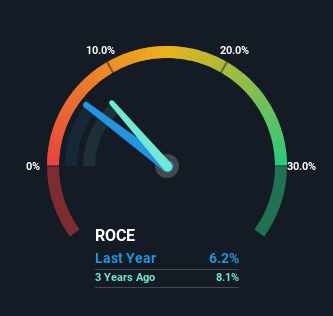- China
- /
- Construction
- /
- SHSE:601390
China Railway Group's (SHSE:601390) Returns On Capital Not Reflecting Well On The Business
If you're not sure where to start when looking for the next multi-bagger, there are a few key trends you should keep an eye out for. Firstly, we'd want to identify a growing return on capital employed (ROCE) and then alongside that, an ever-increasing base of capital employed. Ultimately, this demonstrates that it's a business that is reinvesting profits at increasing rates of return. Although, when we looked at China Railway Group (SHSE:601390), it didn't seem to tick all of these boxes.
Understanding Return On Capital Employed (ROCE)
If you haven't worked with ROCE before, it measures the 'return' (pre-tax profit) a company generates from capital employed in its business. The formula for this calculation on China Railway Group is:
Return on Capital Employed = Earnings Before Interest and Tax (EBIT) ÷ (Total Assets - Current Liabilities)
0.062 = CN¥51b ÷ (CN¥1.9t - CN¥1.0t) (Based on the trailing twelve months to March 2024).
Therefore, China Railway Group has an ROCE of 6.2%. In absolute terms, that's a low return but it's around the Construction industry average of 6.5%.
See our latest analysis for China Railway Group

Above you can see how the current ROCE for China Railway Group compares to its prior returns on capital, but there's only so much you can tell from the past. If you'd like to see what analysts are forecasting going forward, you should check out our free analyst report for China Railway Group .
How Are Returns Trending?
On the surface, the trend of ROCE at China Railway Group doesn't inspire confidence. Around five years ago the returns on capital were 8.4%, but since then they've fallen to 6.2%. Meanwhile, the business is utilizing more capital but this hasn't moved the needle much in terms of sales in the past 12 months, so this could reflect longer term investments. It's worth keeping an eye on the company's earnings from here on to see if these investments do end up contributing to the bottom line.
On a related note, China Railway Group has decreased its current liabilities to 55% of total assets. That could partly explain why the ROCE has dropped. What's more, this can reduce some aspects of risk to the business because now the company's suppliers or short-term creditors are funding less of its operations. Some would claim this reduces the business' efficiency at generating ROCE since it is now funding more of the operations with its own money. Keep in mind 55% is still pretty high, so those risks are still somewhat prevalent.
The Key Takeaway
To conclude, we've found that China Railway Group is reinvesting in the business, but returns have been falling. And investors may be recognizing these trends since the stock has only returned a total of 18% to shareholders over the last five years. So if you're looking for a multi-bagger, the underlying trends indicate you may have better chances elsewhere.
One more thing: We've identified 2 warning signs with China Railway Group (at least 1 which doesn't sit too well with us) , and understanding them would certainly be useful.
For those who like to invest in solid companies, check out this free list of companies with solid balance sheets and high returns on equity.
New: AI Stock Screener & Alerts
Our new AI Stock Screener scans the market every day to uncover opportunities.
• Dividend Powerhouses (3%+ Yield)
• Undervalued Small Caps with Insider Buying
• High growth Tech and AI Companies
Or build your own from over 50 metrics.
Have feedback on this article? Concerned about the content? Get in touch with us directly. Alternatively, email editorial-team (at) simplywallst.com.
This article by Simply Wall St is general in nature. We provide commentary based on historical data and analyst forecasts only using an unbiased methodology and our articles are not intended to be financial advice. It does not constitute a recommendation to buy or sell any stock, and does not take account of your objectives, or your financial situation. We aim to bring you long-term focused analysis driven by fundamental data. Note that our analysis may not factor in the latest price-sensitive company announcements or qualitative material. Simply Wall St has no position in any stocks mentioned.
About SHSE:601390
China Railway Group
Operates as a multi-functional integrated construction company in Mainland China and internationally.
Very undervalued average dividend payer.
Similar Companies
Market Insights
Community Narratives



